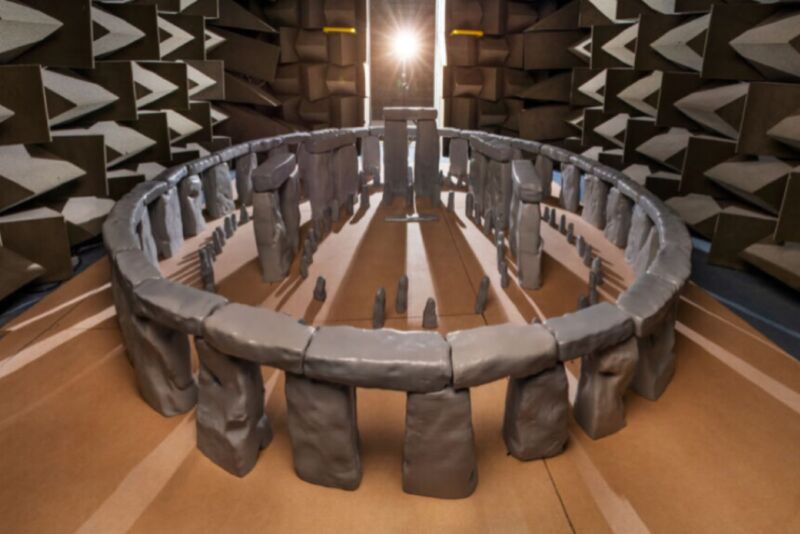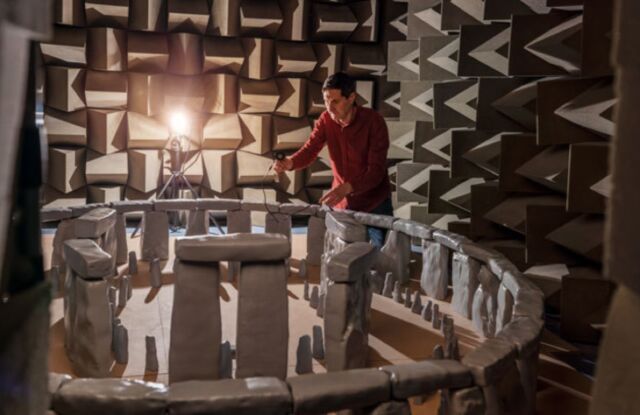
Scientists built a scale model of Stonehenge, the famous megalithic structure of stones in Wiltshire, England, and used it to recreate how sound would have been reflected off the surfaces of the stones. They found that the arrangement of the stones likely would have amplified speech and enhanced music but only if one was within the circle, according to a recent study in the Journal of Archaeological Science.
Dubbed "Stonehenge Lego," the scale model is the work of acoustical engineer Trevor Cox of the University of Salford in England and several colleagues. (Fun fact: way back in 2007/2008, Cox conducted a yearlong study to identify the top 10 worst sounds. The sound of someone vomiting topped the list, followed by microphone feedback, wailing babies, and a train scraping along the track rails.) This latest paper builds on their preliminary findings last year. They've since been working on testing the acoustics of different configurations of the stones that would have existed at different times in the monument's long history.
Recreating historical "soundscapes" is part of a relatively young field known as acoustic archaeology (or archaeoacoustics). For instance, researchers have sought to understand how acoustics may have influenced the outcome of key Civil War battles, like the Battle of Seven Pines on May 31, 1862. Another effect of interest to acoustic archaeologists is the chirping sound—reminiscent of the call of the quetzal, a brightly colored exotic bird native to the region—when you clap your hands at the bottom of one of the massive staircases of the Mayan Temple of Kukulkan at Chichen Itza in central Mexico.
These soundscapes can have practical applications. Case in point: last year, the famed Notre Dame Cathedral in Paris was badly damaged in a fire. Fortunately, French acousticians had made detailed measurements of Notre Dame's "soundscape" over the last few years. Another scientist, Andrew Tallon, had used laser scanning to create precisely detailed maps of the interior and exterior. All that data will be instrumental in helping architects factor acoustics into their reconstruction plans, in hopes of preserving the cathedral's unique soundscape.
Stonehenge, too, has been known to exhibit unusual acoustic effects; it hums in strong winds, for instance. And in 2017, researchers from London's Royal College of Art found that its igneous bluestones produce a loud clanging noise when struck, which those who built the monument may have associated with mystical or healing powers. That could explain why some of those stones were transported such long distances; most were likely quarried in a Welsh town called Maenclochog (translation: "ringing rock"). Apparently, the local townspeople used the bluestones as church bells until the 18th century.
Acousticians have measured the properties of the monument as it exists today, but "the sound is very different from the past because so many stones are now missing or displaced," Cox et al. wrote in their latest paper. There is actually a full-scale model of Stonehenge in Maryhill, Washington, that is closer to its prehistoric formation, and scientists have measured its acoustical properties as well. But Cox et al. believe their scale model more accurately takes into account the shape and size of the actual stones.
"The problem with the other models we have is that the stones aren't quite the right shape and size, and how the sound interacts with the stones depends critically on the shapes," Cox told The Guardian last year. "Those blocks at Maryhill are all very rectangular, whereas real Stonehenge, when you look at it, they are all a bit more amorphous because they are made out of stones that have been hand chiselled."

Cox et al. relied upon laser scans of the site itself, along with existing archaeological evidence, to build their model, which is 1/12th the size of the real thing—as large a replica as the university's acoustic chamber could accommodate. The outer circle of standing sarsen stones likely numbered 30 originally. Today, there are five standing sarsen stones included in a total of 63 complete stones, along with 12 fragmented stones. Archaeologists have estimated a total of 157 stones were placed at the site some 4,200 years ago.
To make their model, Cox and his colleagues 3D-printed 27 stones of varying shapes and sizes. "You 3D print them and then you make silicon moulds out of them, and then you cast them in a plaster-polymer mix, and then you paint them in car paint," Cox told The Guardian. "I ruined my dining room floor." Then they placed the model into the sound chamber to make their measurements.
As we've reported previously, there is a definitive relationship between the quality of a room's acoustics, the size of the chamber, and the amount of absorption surfaces that are present. This is captured in a well-known formula for calculating reverberation time, still the critical factor for gauging a space's acoustical quality. Reverberation is not the same as an echo, which is what happens when a sound repeats. Reverb is what happens indoors when sound can't travel sufficient distance to produce those echoing delays. Instead, you get a continuous ring that gradually "decays" (fades).
Acousticians typically measure so-called "impulse responses" on location and store them digitally for later use. Clap your hands inside an empty concert hall or church. That's the impulse. (A starting pistol or a popping balloon are also good impulses.) The sound reflections you hear are the building's response. Record both impulse and response, then compare the acoustic profile with a recording of just the impulse for reference, and you can extract a model of the room's reverberations.
That's basically what Cox et al. have done with their scale model of Stonehenge. They placed several microphones and speakers throughout the structure, both inside the circle and just outside of it. Then they played chirping sounds of both high and low frequencies through the speakers, and the reflections of the sounds off the model stones were captured and recorded by the microphones.
They found that the reverberation time lasted about 0.6 seconds inside the circle for mid-frequency sounds—ideal for amplifying human speech, or the sounds of musical instruments like drums. (For comparison, your living room probably has a reverb of about 0.4 seconds. A large concert hall typically has a reverberation time of about two seconds, while a cathedral like Notre Dame has a very long reverb of roughly eight seconds.) But those sounds were not projected beyond the circle into the surrounding area, and there were no echoes, since the inner groups of stones served to muddle and scatter the sounds reflected off the outer circle.
Cox and his co-authors are careful to point out that the acoustical properties of Stonehenge were not necessarily the primary driver of the monument's unique design. "It seems improbable that sound was a primary driver in the design and arrangement of the stones at Stonehenge," they wrote. "Other considerations were more likely to be important, including the astronomical alignments, the incorporation of two different groups of stones, the replication of similar timber monuments, and the creation of an impressive and awe-inspiring architecture structure."
This latest study "shows that sound was fairly well contained within the monument and, by implication, [Stonehenge] was fairly well insulated from sounds coming in," archaeologist Timothy Darvill of Bournemouth University in England—who is not affiliated with the new research—told Science News, adding that the unique acoustical properties "must have been one of the fundamental experiences of Stonehenge."
DOI: Journal of Archaeological Science, 2020. 10.1016/j.jas.2020.105218 (About DOIs).
reader comments
69